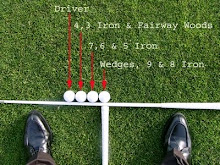The reality is for most players the quickest way to lower your score is with the short game. Here are seven examples of why the short game is so important, just as it is every week on all major professional golf tours, especially this week at Augusta National.
1. Putting -- The one club you will likely use on ever hole is the putter. Roughly 30-40% of your score is going to be with the flat stick. To me, this is a staggering number and one we shouldn't take lightly. Although it seems the masses of amateurs are paying more attention to this area of the game, it is still not where it needs to be. Learning the proper fundamentals of putting and building a repetitive putting stroke like Anthony Kim is something we should all strive to do.
• How many putts per round are you currently taking?
• What percentage does this make of your final score?
• Are you spending that percentage of your practice time on this area of the game?
In 2009, TOUR average for total putts per green was 1.78 with Steve Stricker leading the way at 1.72.
2. Chipping - This by definition is a shot with "minimum air, maximum roll". This is a shot that takes place roughly from 0-10 yards from the green. A short little motion with very little wrists but yet can give so many of us fits. What I like about chipping is it is a great shot to learn how to set-up with the club shaft forward and return it forward to impact supported by the turning of the shoulders.
In 2009, a TOUR player on average would get the ball up and down 85.51% of the time from 10 yards on in. Where are you?
3. Hinge & Hold -- One of my favorite shots and one we have discussed over the years in the blog. Tour players are so good with this shot as we saw from Kim this week when the ball came to rest in the rough. This is a shot you can hit from roughly 0-20 yards and once again, a short motion but different then chipping because of the wrist hinge during the backswing. This wrist hinge steepens the angle of approach into impact resulting in more spin.
In 2009, a TOUR player on average would get the ball up and down 64.74 percent of the time from 10-20 yards.
4. Toss Shot -- A very close second when it comes to my favorite shots and one that generally speaking needs the most work for the amateur player. This shot builds upon the Hinge & Hold by adding more arm swing in both directions allowing for more speed. What's neat about a Toss Shot, it's your first opportunity with the short game to begin to change the club shaft angle at address. Where the two shots before see the club shaft mostly forward at address, the Toss Shot gives you the option to not only lean it forward but also neutral or even slightly back depending upon the situation. These options result into three different trajectories and spin that can be played from roughly 20-60 yards.
In 2009, a TOUR player on average would get the ball up and down 50.53 percent of the time from 20-30 yards.
5. Pitching -- A pitch shot is the logical extension of the Toss Shot. At some point a shot will call for more power than you can generate with the Toss Shot. The difference between the two shots is when Pitching you want to turn your shoulders and coil your upper body during the backswing, where in a Toss Shot, the shoulders will remain quite allowing for just an arm swing with a wrist hinge. A Pitch shot is an extremely important shot as it covers a wide range of distance from roughly 60-110 yards.
6. Lob Shot -- This shot produces the highest trajectory and should be the last choice when selecting from these menu of options. Hitting competent Lob Shots certainly requires practice. Because this shot involves maximum air, minimum roll, there is little margin for error. What's key with this shot is to open the club face and lean the club shaft slightly away from the target at address. These two set-up components will result into more loft and expose the bounce of the club. Approach the Lob Shot more like a Toss Shot where you create a long arm swing with a wrist hinge during the backswing with the body turning towards the target on the downswing.
7. Bunkers -- Of all the shots above -- which one do you think would apply best to the greenside bunker? The answer is the Lob Shot because with Bunker shots we need to utilize the bounce of the sand wedge. Bounce is the difference between the leading edge of the club and trailing edge as measured in degrees. Most sand wedges will have 10-14 degrees of bounce, these degrees of bounce are your friend and when applied properly will slide the club head through the sand rather than dig. With the club face open and club shaft slightly back, you should be all set to create a long and lazy motion resulting in high spinning greenside bunker shots.
In 2009, a TOUR player on average would get the ball up and down 49.44 percent of the time from a greenside bunker.
Source: pgatour.com
Subscribe to:
Post Comments (Atom)





No comments:
Post a Comment